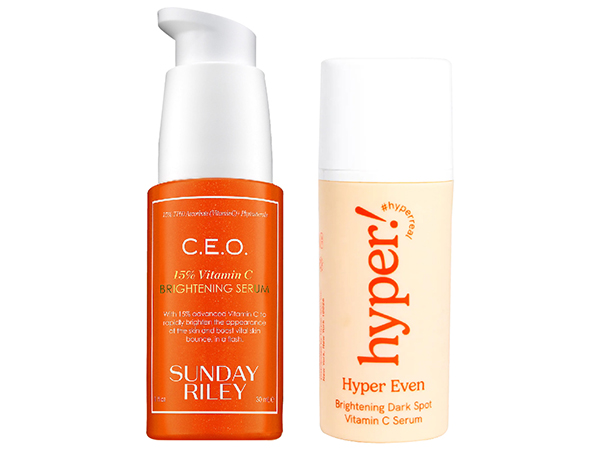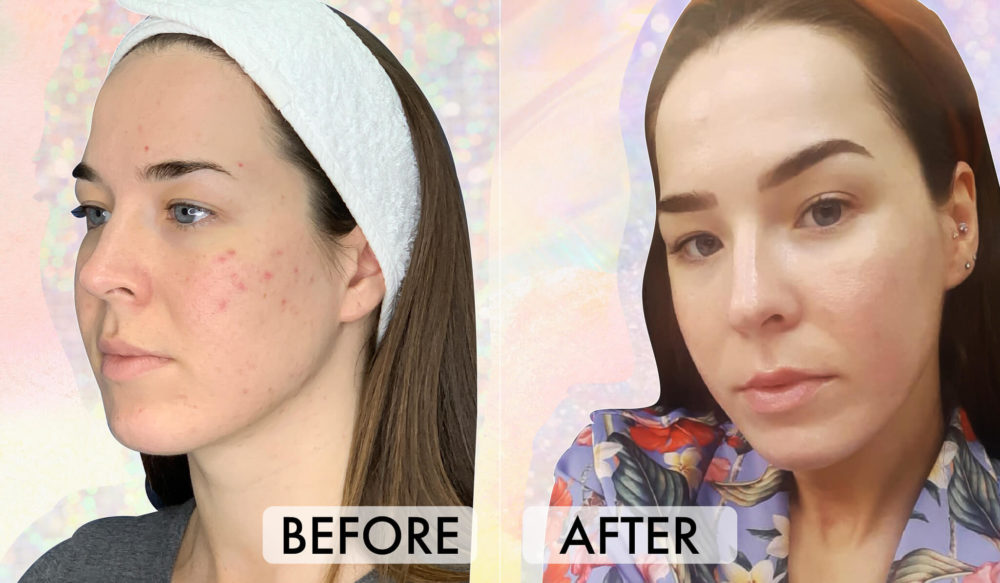How To Choose A Serum To Target Your Skin Concerns

If there’s one skincare product that deserves a permanent spot on your shelf, it’s serums. They help treat almost every skincare concern in the book by delivering a concentrated shot of ingredients straight into your skin. We’re here to help you get to know serums better and clear up any confusion on what they are, what they do, their benefits, different types of serums, and how to choose a serum best for your routine and skin type.
What are Serums?
Serums contain powerful active ingredients and deliver them directly into the dermis. They’re often the most transformative part of a skincare routine, which is why they tend to be pricier. A serum is always applied just before moisturizer, which allows them to penetrate the skin before all that goodness is locked in with a moisturizer.
Serums come in different types of formulas: you can find water-based serums like our WISHFUL Thirst Trap Juice HA3 Peptide Serum, $47, and oil-based like the Freck Beauty Lil Prick Cactus Seed Dry Serum, $40. And you can even find them in lotion or gel-like formulas.
What Do Serums Do?
Anything you want them to – seriously! Serums are the treatment step of your routine and can be used to address any skincare concern you have, whether that’s breakouts or fine lines, hyperpigmentation, or dullness. Just like you have different shoes for different occasions, we also recommend having different serums for different times/ depending on the concerns you would like to address. A classic combo is a vitamin C serum in the morning (which brightens the skin, fades hyperpigmentation, and can even improve fine lines) and a retinol serum in the evening (that targets a ton of skin concerns).
The Difference Between Essences and Serums
Yup, we know you were thinking it. The main difference between serums and essences is the texture. Essences are much more watery and formulated to deeply hydrate the skin and prep it to effectively absorb your following skincare steps. Serums tend to be comparatively thicker and contain more potent actives that treat a broader variety of skin concerns. We love essences, but if we had to pick one, serums win every time!
Posts You'll Love:
How to Choose a Serum
Like everything else in skincare, examining your skin’s needs is crucial before buying a serum. Because they’re so potent, these well-made formulas can quickly solve specific skin concerns like hyperpigmentation, skin texture, fine lines, or dryness. But be sure to look for ingredients that address your skin concerns and work for your skin type. Don’t worry; we’ve laid it out for you:
Types of Serums
Serums typically fall under five categories: Exfoliating, hydrating, balancing, brightening, and firming.
1. Exfoliating Serums
Ingredients like: Lactic acid, azelaic acid, glycolic acid, salicylic acid, and enzymes
Benefits: Decongest pores, brighten dull skin, smooth skin texture, help fade hyperpigmentation, help prevent breakouts
What they do: Chemically slough dead skin cells away by loosening the bonds between dead skin cells for smoother texture and a radiant complexion.
Suitable for: It depends on the exfoliators used and how it’s formulated, but typically azelaic works best for sensitive skin types, while salicylic acid is better for oily and combination skin types.
When to use: At nighttime.
 Source: Paula’s Choice, The Ordinary
Source: Paula’s Choice, The Ordinary
Our top picks:
- Paula’s Choice Skin Perfecting 2% BHA Liquid Exfoliant, $34: A salicylic acid-fueled serum that sheds dead skin cells and purifies pores as green tea soothes for improved skin tone and texture.
- The Ordinary Lactic Acid 5% + HA, $8: A vegan liquid-to-peel formula that exfoliates mildly with 5% lactic while Tasmanian pepperberry calms.
2. Hydrating Serums
Ingredients like: Hyaluronic acid (sodium hyaluronate), polyglutamic acid, glycerin, squalane, and ceramides
Benefits: Healthier skin, dewy-looking complexion, improves the appearance of fine lines
What they do: Hydrates the skin by capturing water into its top layer (epidermis) for plumper and softer skin. Hydrating serums can usually be used as a booster alongside other serums, which means they can be easily layered with other formulas.
Suitable for: All skin types.
When to use: Daytime and/or nighttime
 Source: The INKEY List
Source: The INKEY List
Our top picks:
- WISHFUL Thirst Trap Juice HA3 Peptide Serum, $47: Boosted with three types of hyaluronic acid, this peptide-powered elixir hydrates and strengthens your skin back to its healthiest state alongside moisturizing hollyhock rose and soothing aloe vera.
- The INKEY List Hyaluronic Acid Hydrating Serum, $10: An easy-to-absorb hydrator that pulls and locks in moisture for a plump feel.
3. Balancing Serums
Ingredients like: Ceramides, cica, zinc, niacinamide, and peptides
Benefits: Stronger skin barrier, healthier skin, better hydration, fewer breakouts or dryness
What they do: Nourish and strengthen the skin’s barrier for increased suppleness and moisture retention.
Suitable for: All skin types.
When to use: Daytime and/or nighttime
 Source: Glow Recipe, Cocokind
Source: Glow Recipe, Cocokind
Our top picks:
- Glow Recipe Avocado Ceramide Redness Relief Serum, $44: A skin-soothing serum doused in ceramides and antioxidant-rich avocado that nourishes and calms dehydrated skin.
- Cocokind Ceramide Barrier Serum, $22: This barrier-boosting serum nurses skin back to health with five types of ceramides and lipids while hydrating lactic acid gently exfoliates for prime absorption.
4. Brightening Serums
Ingredients like: Niacinamide, Kojic acid, vitamin C, alpha arbutin, and tranexamic acid (specifically for hyperpigmentation)
Benefits: Brighter skin, smoother skin texture, reduced dark spots & hyperpigmentation
What they do: Brightening serums work in several ways depending on what they contain. Their primary goal is to trigger collagen and elastin production that repairs the skin while helping even skin tone by slowing down the excess production of melanin-forming enzymes (called tyrosinase), thereby helping to prevent dark spots and discoloration from forming.
Suitable for: All skin types, particularly those dealing with hyperpigmentation, acne scars, or dullness. Sensitive skin types should look for products formulated for sensitive skin.
When to use: Daytime and/or night (always use an SPF during the day)
 Source: Sunday Riley, Hyper Skin
Source: Sunday Riley, Hyper Skin
Our top picks:
- Sunday Riley C.E.O. 15% Vitamin C Brightening Serum, $85: A vitamin C-powered juice that brightens, blurs the appearance of pores, and smooths fine lines for a natural glow.
- Hyper Skin Hyper Clear Skin Vitamin C Serum, $58: A vegan hyperpigmentation hard-hitter that softens acne scars, sun damage, and dark spots with vitamin C and Kojic acid. Anti-inflammatory turmeric and salicylic acid keep breakouts at bay.
5. Firming Serums
Ingredients like: Retinol, peptides, bakuchiol
Benefits: Firmer & plumper skin, which helps prevent and reduce fine lines
What they do: Speed up skin cell turnover or increase collagen production (depending on the ingredient) while strengthening the skin’s barrier and improving the appearance of fine lines and wrinkles.
Suitable for: All skin types, depending on the formula. Peptides and bakuchiol are more suitable for sensitive skin types.
When to use: At nighttime
 Source: Medik8, Versed Skincare
Source: Medik8, Versed Skincare
Our top picks:
- Medik8 Crystal Retinal, $53: It contains retinaldehyde, a next-gen vitamin A form that delivers smoother-looking skin 11 times faster than retinol. The addition of hyaluronic acid and glycerin ensures your skin stays hydrated.
- Versed Skincare Press Restart Gentle Retinol Serum, $22: A sensitive-skin-approved retinol serum that evens discoloration and softens the appearance of fine lines with microencapsulated retinol and natural retinol alternatives (arophira and bakuchiol).
How to Use a Serum:
Apply serums after you’ve cleansed and toned but before your moisturizer and face oil. Here are some must-know tips for application:
Serum Application
Unlike moisturizers, serums tend to absorb quickly, so a simple pat-pat-pat is enough to help them penetrate. Thanks to how potent they are, you only need a small amount – about the size of two pomegranate seeds. Bonus: money saved!
How to Layer Serums
If you’re using more one than serum – a hydrating serum like the WISHFUL Thirst Trap Juice HA3 & Peptide Serum, $47, and a vitamin C serum – apply the serum with the thinnest texture first, which is the basic rule of skincare layering. But before you do, check whether they work together. For example, layering a retinol-based serum over an exfoliating serum could irritate your skin! As a general rule, hydrating or balancing serums can be mixed with any other serum, while the others shouldn’t be layered together. And two serums per morning or evening routine should be plenty – these are potent, so mixing more doesn’t equal more benefit.
Check out our layering guide for more info on how to apply all your skincare products together.























Leave a comment